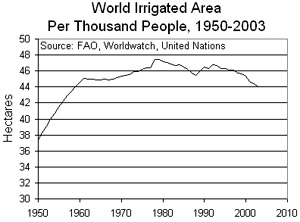
|
WORLD’S WATER RESOURCES FACE MOUNTING PRESSURE 26 July 2006 :: Elizabeth Mygatt Global freshwater use tripled during the second half of the twentieth century as population more than doubled and as technological advances let farmers and other water users pump groundwater from greater depths and harness river water with more and larger dams. As global demand soars, pressures on the world’s water resources are straining aquatic systems worldwide. Rivers are running dry, lakes are disappearing, and water tables are dropping. Nearly 70 percent of global water withdrawals from rivers, lakes, and aquifers are used for irrigation, while industry and households account for 20 and 10 percent, respectively. Pressure on water resources is particularly acute in arid regions that support agricultural production or large populations—regions where water use is high relative to water availability. The Middle East, Central Asia, North Africa, South Asia, China, Australia, the western United States, and Mexico are especially prone to water shortages. Much of the growth in water use over the past half-century is from a vast increase in irrigation, which is used to produce 60 percent of the world’s grain. Globally, irrigated area nearly tripled between 1950 and 2003, growing from 94 million to 277 million hectares. This growth, however, is tapering off as the water needed to expand irrigation becomes increasingly scarce. Forty years ago, irrigated area was expanding at an annual rate of 2.1 percent, but the last 5 years of data reflect slower growth of only 0.4 percent. Since governments are more likely to report gains from new projects than losses as wells go dry, as rivers dry up, or as irrigation water is diverted to cities, these estimates may be high and irrigated area may have already peaked. (See Figure and Table.)
Meanwhile, the extent of irrigated area per person reached a high of 47 hectares per thousand people in 1978 and has been shrinking steadily since 1992. In 2003, per capita irrigated area dropped below 44 hectares per thousand people, the lowest level of the past four decades. With population growth outpacing growth in irrigated area, this figure is unlikely to rebound substantially. As demand for water continues to grow in order to satisfy rising agricultural, industrial and residential needs, aquatic ecosystems struggle to respond. Countless communities depend heavily on rivers, both for direct water use and as a source of energy. But as upstream populations increase their demands, downstream communities have less water available to them. In some cases, rivers become so overexploited that they cease to exist altogether. The Amu Darya in Central Asia and the Colorado in the southwestern United States are among the world’s rivers that run dry for at least part of the year. Water from the Amu Darya, once the largest tributary of the Aral Sea, is diverted to irrigate the cotton fields of Central Asia. The Colorado’s flow is depleted by southwestern farmers and thirsty cities alike, with over one fourth of these withdrawals—3.8 trillion liters—going to California alone. At times during 18 of the last 26 years of the twentieth century, China’s Yellow River failed to make it to the sea. In recent years, however, better management and greater reservoir capacity have facilitated year-round flow. Other rivers, including the Ganges, the Indus, and the Nile, are sometimes little more than a trickle by the time they reach the sea. (See Table of Major Rivers Running Dry.) As rivers run dry, the lakes that rely on them suffer as well. Lake shorelines are receding and water levels are dropping due to dramatic reductions in inflow from rivers and streams, declining recharge from overstressed aquifers, and increasing water withdrawals from lakes. For example, the Dead Sea has dropped by 25 meters (82 feet) in the past 40 years, and Mono Lake in California has fallen by 11 meters since 1941, the year Los Angeles first began to draw water from its tributaries. Lake Chad, once spanning 23,000 square kilometers in Nigeria, Niger, Cameroon, and Chad, now covers just 900 square kilometers and exists entirely within Chad’s borders, rendering earlier maps obsolete. China’s Hebei Province has lost 969 of its 1,052 lakes. In Central Asia, historic ports built on the shores of the Aral Sea are now up to 150 kilometers from the water’s edge. Water levels dropped so low that the sea split in two in the late 1980s. While the South Aral Sea, intermittently fed by the weakened Amu Darya, will likely never recover, recent efforts to revitalize the North Aral Sea have raised water level from 30 to 38 meters, close to the 42-meter level of viability. (See Table of Disappearing Lakes and Shrinking Seas.) Falling water tables are less obvious indicators of global water shortages than disappearing lakes and dry riverbeds. Yet groundwater reserves are becoming increasingly depleted, due in large part to the rise in irrigated area and the growing use of water for industrial purposes. Fossil aquifers, which supply irrigation water to some of the world’s major grain producers, are of particular concern because they cannot be replenished. Aquifers are being overexploited in major food-producing regions, including the North China Plain, a region that yields half of China’s wheat and one third of its corn; Punjab, Haryana, and other highly productive agricultural states in northern India; and the southern Great Plains of the United States, a major grain-producing region. Together, China, India, and the United States produce nearly half the world’s grain, and these three countries plus Pakistan collectively account for over three fourths of the world’s reported groundwater extraction for agricultural purposes. Falling water tables in these countries may make expanding world food production more difficult. (See Table of Underground Water Depletion in Key Countries.) While groundwater is integral to today’s agriculture, it is also a valuable resource in urban environments. Some of the world’s largest cities, including Mexico City, Calcutta, and Shanghai, rely heavily on local groundwater. Thirty percent of China’s urban water supply is fed from groundwater. Worldwide, it is estimated that roughly 2 billion people—in both rural and urban environments—rely on groundwater for daily water consumption. With the projected addition of 2.6 billion people to the global population by 2050, most of them in countries where water tables are already falling and wells are going dry, water shortages will likely become more commonplace and more severe. Absent a global effort to quickly slow population growth and to use water more efficiently, water shortages may translate into food shortages in more and more countries. Originally Published online: 26 July 2006
'THE WIND RUSH IS ON' IN TEXAS TEXAS TO BUILD 500 OFFSHORE TURBINES, LARGEST OFFSHORE WIND FARM IN U.S. 15 May 2006 State authorities in Texas have announced plans to build the nation's largest offshore wind farm. The facility would be built about 10 miles off Padre Island in the Gulf of Mexico and would consist of 500 wind-harvesting turbines, 400 feet in height. [Full Story] THE COMING DECLINE OF OIL When the price of oil climbed above $50 a barrel in late 2004, public attention began to focus on the adequacy of world oil supplies —and specifically on when production would peak and begin to decline. Analysts are far from a consensus on this issue, but several prominent ones now believe that the oil peak is imminent. [Full Story] WORLD WATER DAY HIGHLIGHTS EFFECTS OF POVERTY, CLEAN WATER SCARCITY ON 1 BILLION WORLDWIDE Parts of east Africa have not seen rain for six years and six nations there are facing extreme famine. Through events organized by UNESCO, the UN and NGOs are hosting World Water Day today, to raise awareness of the problem of scarcity of safe drinking water affecting an estimated 1 billion people worldwide. [Full Story] GREEN LIGHT FOR RENEWABLE FUELS Renewable fuels have enjoyed a lot of attention in recent months, in a market driven by escalating oil costs, strained fuel stocks, worsening environmental degradation, and promises by the G8 to reduce carbon emissions. Revelations about the vulnerabilities inherent in the fossil fuel infrastructure, together with new technological advances in wind- and solar-based power generation mean renewables are now directly competitive with traditional fuel sources. [Full Story] |
||||||||||||||||||||||||||||||||
|
|||||||||||||||||||||||||||||||||













